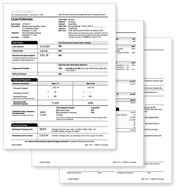CFPB RESPA/TILA Rule Reference: 5.5, Page 25-26, CFPB Detailed Summary of the Rule
The forthcoming Loan Estimate (LE) disclosure replaces the GFE and the Initial TIL for most mortgage loans as of August 2015. If you missed our previous post, start at the beginning of this series with an overview of the development and purpose of the new Loan Estimate form.
 The first page of the Loan Estimate disclosure includes general information about the loan including:
The first page of the Loan Estimate disclosure includes general information about the loan including:
- A loan terms table with descriptions of information about the loan including loan amount; interest rate; monthly principle and interest payment amounts; prepayment penalties, if applicable; and balloon payment information, if applicable.
- A projected payments table which breaks down by month or year exactly how each monthly payment would be calculated including specifics for principle, interest, mortgage insurance, and estimated escrow. This section also includes estimates for the costs of taxes, insurance, and assessments.
- A costs at closing section which explicitly states the total costs of closing and the estimated cash to close amount; both of these figures are detailed on Page 2 of the form.
One goal coming out of the “Know Before You Owe” initiative was to assist consumers with comparing their estimated costs to their final costs. One way this goal is being met is that the final Closing Disclosure Form (CFD) will resemble the LE form very closely. With this approach, consumers will be able to clearly determine whether or to what extent final costs rose or fell with regard to their original estimates. It’s for the sake of this comparison that the Consumer Financial Protection Bureau has been very precise with instructions for creating the forms—even including some seemingly cosmetic requirements.
While lenders are welcome to add company logos and slogans to certain areas of the form, most areas have prescribed information including a statement at the top instructing consumers to, “Save this Loan Estimate to compare with your Closing Disclosure.” Also, the bottom of the page must mention that consumers can find information and tools at a specific URL maintained by the CFPB.
As mentioned in previous posts, these Loan Estimates must be generated and sent within three days of consumer application, and once these forms are sent, the lender is generally bound to the figures with very few exceptions.
In order to manage this huge shift in loan application operations, lenders will need to have both a plan and the tools to get these documents out the door within three days and also to ensure that they’re at least as accurate (if not more) than the Good Faith Estimates being generated today.
We elaborate more on how this impacts business, and how technology solutions mitigate that impact, in the knowledge article titled “A look at the business impacts of the Loan Estimate form” in the TILA-RESPA Knowledge Center.
All information and views expressed or implied are provided without warranty and are only the opinion of Pavaso, Inc. Each participant should seek legal representation for legal interpretation of the ruling and the CFPB directly for final instruction and interpretation. The final rule can be found here.





